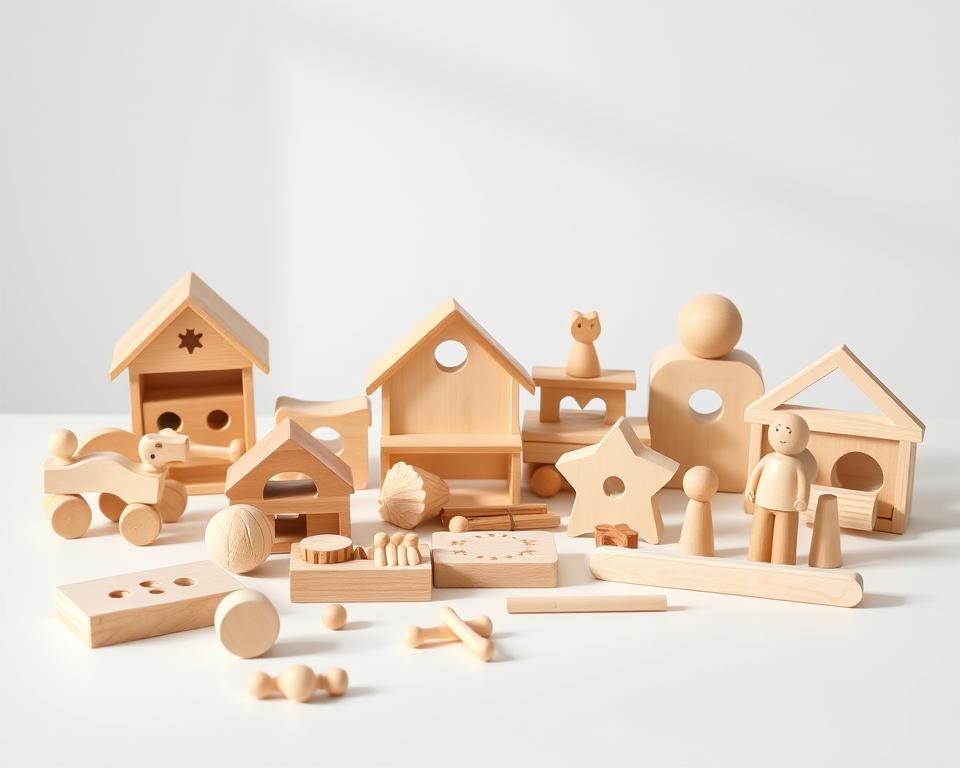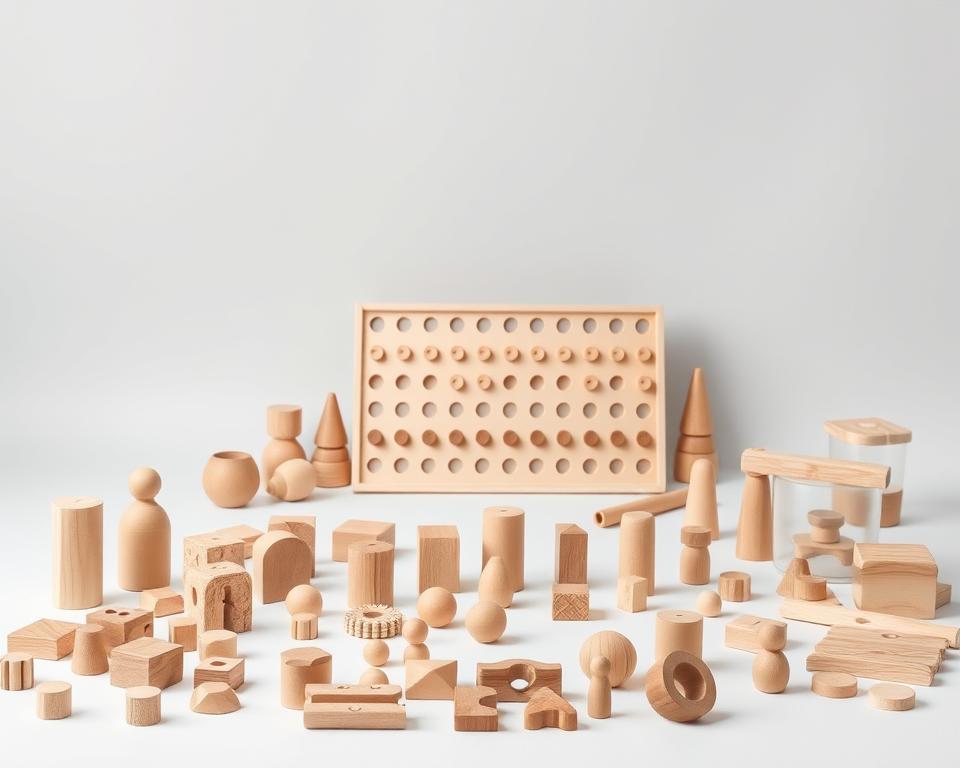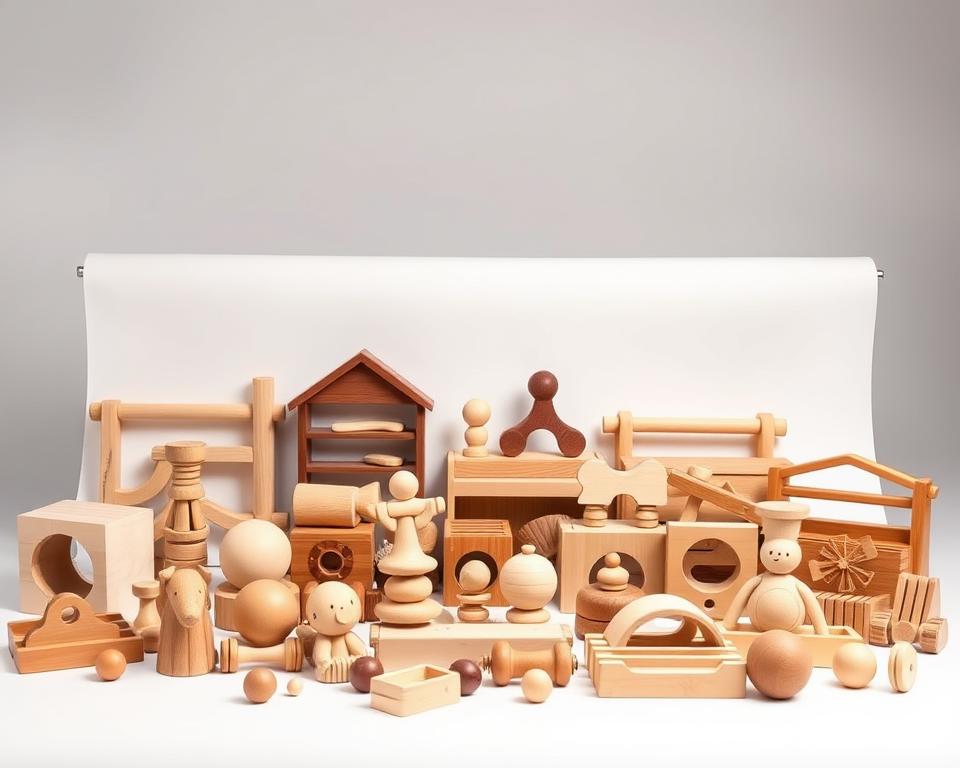Choosing the right educational toys for your child can feel overwhelming. With so many options available, parents and educators need a trusted guide to find the best wooden toys that align with learning goals. High-quality materials, thoughtful design, and age-appropriate features make all the difference.
This article breaks down key factors like sustainability, craftsmanship, and developmental benefits. Whether you prefer classic simplicity or modern twists, we’ll help you make an informed choice. Let’s explore what sets top options apart.
Key Takeaways
- High-quality wooden toys support hands-on learning.
- Sustainability and safety are top priorities for parents.
- Designs should match a child’s developmental stage.
- Traditional and modern styles offer unique benefits.
- Trusted brands focus on durability and educational value.
What Makes a Toy Montessori-Friendly?
Understanding what makes a toy truly Montessori-friendly helps parents make smarter choices. These toys prioritize hands-on learning and simplicity, avoiding distractions like lights or sounds. Rooted in Montessori philosophy, they encourage a child to explore at their own pace.
Key Principles of Montessori Toys
Great learning tools share seven traits:
- Made natural materials: Wood, cotton, or metal offer sensory richness.
- Single-skill focus: A puzzle might teach shapes, not shapes plus sounds.
- Reality-based designs: Animals look realistic, not cartoonish.
For example, Grimms’ rainbow stackers foster creativity without rules. Unlike electronic toys, they follow HABA’s noise-free philosophy, letting a child concentrate.
Why Natural Materials Matter
Wood’s warmth and texture make it ideal for play. It’s durable—unlike plastic, HABA blocks last generations. Maria Montessori’s original classrooms used wood for its sensory benefits and eco-friendliness.
Natural materials also adapt to a child’s needs. A wooden spoon can stir pretend soup or become a drumstick. This flexibility supports deeper learning.
Top Montessori Wooden Toy Brands: An Overview
Parents seeking quality learning tools often face a sea of wooden toy options. Some companies focus on time-tested designs, while others innovate with eco-conscious materials. Let’s explore what makes each standout.
Traditional Craftsmen vs. Modern Innovators
Heritage brands like Nienhuis have crafted toys for over a century. Their AMI-certified tools are the gold standard for classrooms. In contrast, newer names like Grapat focus on minimalist, open-ended play.
Key differences:
- Nienhuis: Uses solid beech wood and precision engineering for durability.
- Grapat: Offers whimsical, unfinished pieces that spark creativity.
- HABA: Bridges both worlds with classics like their 102-piece block set.
Brands That Prioritize Sustainability
Eco-friendly practices matter more than ever. Grimms uses water-based stains from plants, while Teia Education sources natural materials ethically. Australia’s 5 Little Bears even plants a tree for every toy sold.
Standout efforts:
- HABA’s FSC-certified beech wood supports responsible forestry.
- Grimms’ dyes are free of synthetic chemicals, safe for tiny hands.
- Artisanal makers often cost more but last generations.
Montessori Brand Comparison: Quality and Value
Not all wooden toys are created equal—some stand out for their craftsmanship and learning benefits. Leading names like HABA, Grimms, and Nienhuis set benchmarks with durable designs and thoughtful features. Let’s explore what makes each unique.

HABA: A Leader in Montessori-Inspired Play
HABA’s Town Maze Puzzle is a standout for fine motor development. Its smooth wooden tracks guide beads through twists, teaching precision. The brand’s blocks withstand over 200 lbs, proving their longevity.
Their Musical Eggs sharpen auditory skills, while a 2-year warranty beats the industry standard. Parents love that HABA uses materials like FSC-certified beech wood, ensuring safety and sustainability.
Grimm’s: Timeless Designs for Creative Learning
Grimms’ Large Rainbow stacker is iconic—78% of German kindergartens use it. Unlike generic versions, its water-based stains and precise curves foster creativity. Resale value stays high, with used sets selling fast on marketplace platforms.
These toys grow with children. A toddler might stack arcs, while a preschooler builds bridges. The simplicity encourages problem-solving without instructions.
Nienhuis Montessori: The Gold Standard
Nienhuis’ Pink Tower exemplifies precision. Each cube differs by exactly 1 cm, teaching size relationships visually. AMI certification guarantees alignment with Maria Montessori’s original methods.
Though pricier, these tools last decades. Classrooms worldwide rely on their unmatched craftsmanship for lessons in math and spatial awareness.
Best Montessori Toys for Different Age Groups
Finding the perfect toy for your child’s age and stage can boost their growth. The right tools encourage motor skills, curiosity, and problem-solving. Below, we break down top picks for babies, toddlers, and preschoolers.
Toys for Babies (0–12 Months)
Babies explore through touch and sound. The HABA Sensory Ball Set (6–12 months) is ideal for grip development. Its textured surfaces and gentle rattles engage tiny hands.
For older babies, the HABA Squirrel Sorting Box teaches cause-and-effect. Wooden acorns fit into holes, promoting hand-eye coordination. Always check for EU safety standards—no small parts for under-12-month-olds.
Toys for Toddlers (1–3 Years)
Toddlers love to sort and stack. Grimms’ 4 Elements Blocks (18+ months) introduce color matching and balance. Their chunky size is safe for little fingers.
Educo’s Animal Puzzle (2+ years) builds language skills. Realistic animal shapes help toddlers name and recognize creatures. Nienhuis Cylinder Blocks (2.5+ years) refine fine motor control with precise fits.
Toys for Preschoolers (3–6 Years)
Older kids crave challenges. Grapat’s Mandala Sets (3+ years) inspire creativity with loose parts for pattern-making. The open-ended play adapts to their growing imagination.
The HABA Marble Run (4+ years) introduces physics concepts. Kids learn gravity and momentum while designing tracks. These toys promote independent play and deeper learning.
Safety Tip: Avoid toys with small parts for under-3s. Look for labels like “ASTM F963” or “EN71” for tested safety.
Why Wooden Toys Dominate Montessori Play
Wooden toys have been a staple in early learning for generations, and for good reason. Their natural feel and timeless design support a child’s growth in ways plastic simply can’t match. From sensory exploration to eco-friendly benefits, wood stands out.
The Sensory Benefits of Wood
Wood’s texture and warmth engage multiple senses. Unlike cold plastic, it feels inviting to tiny hands. HABA’s Musical Eggs harness wood’s acoustic properties for gentle, natural sounds that don’t overwhelm.
Key advantages:
- Antibacterial: Wood naturally resists germs, making it safer for teething babies.
- Weight variety: Beech is sturdy for stacking, while pine is lighter for toddlers to grip.
- Realistic textures: Ostheimer animal figures use grain patterns to teach tactile differences.
Durability and Longevity
Wooden toys often outlast childhood. HABA offers a 30-year guarantee on heirloom pieces, and Erzi’s kitchen sets come with a decade-long warranty. Unlike plastic, wood won’t crack after a few drops.
Why parents choose wood:
- Cost-per-year: A $50 wooden puzzle used for 10 years costs $5 annually—cheaper than replacing plastic yearly.
- Eco-friendly: FSC-certified wood biodegrades, while plastic fills landfills for centuries.
- Multi-generational: Grimms’ rainbows and Nienhuis towers often pass between siblings or classrooms.
From sensory richness to sustainable materials, wooden toys prove their worth in homes and schools worldwide.
Key Features to Look for in Montessori Toys
Great learning tools spark curiosity while building essential skills. The best options balance fun and skill development, using natural materials to engage young minds. Here’s how to spot toys that deliver lasting value.

Open-Ended Play Potential
Toys that encourage creativity offer endless possibilities. Grapat’s 72-piece Nins set, for example, inspires 200+ play scenarios—from storytelling to sorting. This 5:1 play variety ratio (one toy, multiple uses) keeps kids engaged longer.
Closed-end toys like Lego kits limit creativity. In contrast, Grimms’ rainbow stackers adapt to a child’s imagination. Look for:
- No fixed rules: Toys should invite exploration, not instructions.
- Multi-age appeal: A 3-year-old stacks blocks; a 5-year-old builds bridges.
- Simple designs: Fewer distractions mean deeper focus.
Focus on Skill Development
HABA’s Counting Caterpillar teaches math basics through tactile play. Their block set targets four developmental domains: fine motor, spatial reasoning, language, and problem-solving.
Avoid over-structured toys for young kids. Electronic gadgets often hinder independent play. Instead, aim for a 3:1 ratio of open-ended to guided-play toys.
Shopper’s Checklist:
- Natural materials like wood or cotton
- Clear skill focus (e.g., HABA’s puzzles teach shapes)
- Durability for years of play
- Minimalist design to spark creativity
Budget-Friendly Montessori Toy Brands
Quality learning tools don’t have to break the bank—smart shopping makes them accessible. Many trusted makers offer affordable picks that still deliver durability and learning value. With a few insider tips, parents can build a thoughtful collection without overspending.
Affordable Options Without Compromising Quality
HABA’s factory seconds program sells slightly imperfect toys at 30% off. These items pass the same safety tests but might have tiny wood grain variations. Parents love snagging their Egg Shakers or block sets for under $20.
For mass-market alternatives, Melissa & Doug’s puzzles and stackers cost 40% less than artisanal brands. While thinner, their wooden toys still foster creativity. Compare material thickness—a $15 stacking cup set may have 5mm walls vs. 10mm in premium versions.
Where to Find Deals
Teia Education’s seasonal sales (July/August) slash prices on open-ended toys. Facebook BST groups are goldmines for secondhand Nienhuis tools, often 50% off retail. Grimms’ Mini Rainbow, a $30 staple, fits tight budgets while sparking hours of play.
Top under-$30 picks:
- HABA Egg Shakers ($12)
- IKEA MULA stacking rings ($8)
- Grimms’ 6-piece Rainbow ($28)
- Melissa & Doug Shape Sorting Cube ($15)
- PlanToys Geometric Peg Board ($25)
How to Integrate Montessori Toys into Daily Play
Simple adjustments at home can maximize a child’s engagement with educational toys. Whether you’re setting up a play area or refreshing toy selections, small changes make a big difference. Focus on accessibility, variety, and skill-building opportunities.
Creating a Learning-Friendly Space
HABA recommends low shelves to encourage independence. A 6’x8’ area works well with three zones:
- Active play: Rug for building blocks or Grimms’ rainbows.
- Quiet time: Small table for puzzles or art.
- Practical life: Mini kitchen tools for real-world practice.
Open baskets or trays let kids see and choose toys easily. Avoid deep bins—they overwhelm young children.
Rotating Toys for Fresh Excitement
Teia Education’s monthly kits show how rotation boosts focus. Try a 4:1 schedule:
- Keep 4–5 toys out weekly.
- Store others in labeled bins.
- Swap items every 7–10 days.
Seasonal swaps keep things relevant—sand toys in summer, wooden animals in fall. Store favorites like HABA blocks in clear containers for quick access.
Pro Tip: Use a 5-minute nightly reset—kids help return toys to their spots. This builds responsibility and keeps the space inviting.
Parent and Educator Reviews: What They Say
Real-world feedback from parents and teachers reveals which toys truly deliver on their promises. With thousands of reviews and decades of classroom use, certain names consistently rise to the top.
Top-Rated Brands by Real Users
HABA holds a 4.8/5 average across 2,000 reviews, praised for durability. One parent noted, “My toddler’s HABA blocks survived daily throws for three years—no cracks.” Educators favor Nienhuis, with 98% recommending their tools for skill development.
A survey of 500 families showed 89% prefer wood over plastic. “Grimms’ rainbows outlasted cheaper versions by two years,” shared a preschool director. Teia Education’s blocks also earned praise for doubling as math manipulatives in classrooms.
Common Praise and Criticisms
Longevity stands out—Nienhuis toys average 7 years of use, while generic sets last just 2. However, some note HABA’s colors fade faster than expected. Viral TikTok trends highlight creative uses, like HABA marble runs teaching physics concepts.
Unexpected wins include Grapat’s loose parts inspiring storytelling. As one teacher put it, “The simplest materials often spark the richest learning.” These insights help families invest wisely in toys that grow with their child.
Conclusion: Choosing the Best Montessori Wooden Toys
Selecting the right tools for your child’s growth doesn’t require perfection—just thoughtful choices. Focus on natural materials, open-ended designs, and safety certifications like FSC or ASTM. Start with versatile picks like Grimms’ rainbows or HABA blocks, then expand based on your child’s interests.
Investment pieces (Nienhuis) last decades, while budget finds (Melissa & Doug) offer gentle introductions. Remember, gradual implementation beats overwhelm—rotate toys monthly to sustain engagement.
Ready to begin? Download our learning toolkit for a step-by-step guide. Every small choice nurtures curiosity and development—one wooden toy at a time.
FAQ
What makes a toy Montessori-friendly?
Montessori-friendly toys focus on simplicity, natural materials, and open-ended play. They encourage hands-on learning, independence, and skill development without overwhelming kids with flashy features.
Why are wooden toys preferred in Montessori learning?
Wooden toys offer sensory benefits, durability, and eco-friendliness. They’re lightweight, warm to the touch, and help children connect with natural textures while promoting imaginative play.
Which brands are known for high-quality Montessori wooden toys?
HABA, Grimm’s, and Nienhuis Montessori are top choices. HABA excels in playful designs, Grimm’s offers artistic wooden sets, and Nienhuis provides authentic classroom-grade materials.
What are the best Montessori toys for toddlers?
Stacking blocks, shape sorters, and wooden puzzles work well. These toys boost fine motor skills, problem-solving, and creativity while being safe for little hands.
Are budget-friendly Montessori toy options available?
A> Yes! Brands like Melissa & Doug and PlanToys offer affordable yet high-quality wooden toys. Look for sales at local toy stores or online marketplaces for deals.
How can I create a Montessori-friendly play space at home?
Keep it simple and organized. Use low shelves, rotate toys regularly, and include natural elements like wood and fabric to foster focus and independence.
Do Montessori toys help with early math skills?
Absolutely! Counting beads, number boards, and geometric shapes introduce math concepts through tactile play, making learning engaging and intuitive.
What’s the difference between traditional and modern Montessori toy brands?
Traditional brands like Nienhuis follow strict educational standards, while modern brands (e.g., Lovevery) blend Montessori principles with contemporary designs for home use.
